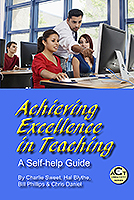Key Information
Achieving Excellence in Teaching: A Self-help Guide, By Charlie Sweet, Hal Blythe, Bill Phillips, & Chris Daniel
2014 [ISBN: 1-58107-259-9; 136 pages; 6 x 9 inch; softcover] $20.95
 So, how do college faculty and high school teachers become better teachers? Too often through trial and error as well as modeling their graduate professors. Aye, and there’s the rub. First-year millennial students do not respond well to the same methodology employed by graduate school instructors used to smaller seminars, a built-in interest factor, and highly motivated students. And if newly-minted doctors underwent the same trial and error period, they would spend more time in the courtroom than in actual practice. Fortunately, teachers are not being sued for their lackluster classroom methods – not yet anyway.
So, how do college faculty and high school teachers become better teachers? Too often through trial and error as well as modeling their graduate professors. Aye, and there’s the rub. First-year millennial students do not respond well to the same methodology employed by graduate school instructors used to smaller seminars, a built-in interest factor, and highly motivated students. And if newly-minted doctors underwent the same trial and error period, they would spend more time in the courtroom than in actual practice. Fortunately, teachers are not being sued for their lackluster classroom methods – not yet anyway.
This book is a self-help guide for high school and college teachers who want to improve their skills and measure that improvement. Hence, the authors enclose a chapter on that assessment system — RATE (Rubric for Achieving Teaching Excellence). The only book devoted to teaching improvement that combines research-based, highly effective teaching practices with a self-help guide, Achieving Excellence in Teaching is written in an easy-to-read, conversational style.
This book is designed not only to provide you with a tightly focused set of strategies, selecting only the most fundamental and powerful, but also to offer you a user-friendly method to access your level of success through employment of the strategies.
With the authors’ goal of measurable self-improvement in mind, they’ve developed a set of rubrics keyed to each chapter, allowing you to assess where you currently stand as an instructor. Using a Likert scale, the rubrics ask you to evaluate such things as your attitude toward teaching, your alignment of student learning outcomes (SLOs) in your classes with those of larger academic units, and your delivery of class material. At the book’s end you’ll find a series of rubrics that replicate those in the earlier chapters. Comparison of your responses after experimenting with the various strategies offered throughout the text should provide a solid assessment of the handbook’s effectiveness.
So, you may start today on a focused, fast path to achieving teaching excellence in your classrooms.
The Contents
Preface
1. Introduction
2. Using R.A.T.E. (a Rubric for Achieving Teaching Excellence
3. Deep Learning
4. Dispositions
5. Passion
6. Caring
7. Rapport
8. Excellence
9. Organization
10. Teaching Paradigms and Authority
11. Technology
12. Scholarly Teaching
13. Teaching Creatively
14. Synthesizing an Optimal Learning Environment
Afterword
Appendix A: R.A.T.E.s
The Authors
Hal Blythe, Ph.D., is a Foundation Professor of English at the Eastern Kentucky University, Richmond, KY. He has authored three non-fiction books dealing with writing and over 100 critical scholarly articles. He has ghost-written over 30 Mike Shayne novellas and over 100 short stories in popular magazines to include Ellery Queen’s Mystery Magazine and Woman’s World. He also has produced seven television scripts for EKU-TV’s Keys to Communication Series, and over 25 articles in Writer’s Digest dealing with pedagogy.
Charlie Sweet, Ph.D., is a Foundation Professor of English at Eastern Kentucky University. He formerly taught at Florida State University.
